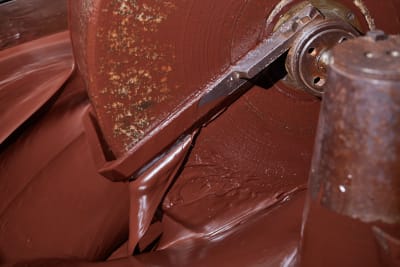I once visited a U.S. company that manufactured both dairy and pareve kosher-certified chocolate. This is what the process looked like. They start off putting dry, powdered ingredients like sugar and cocoa powder through a refiner, which is a series of rollers that crush the powder to make it even finer, each successive roller grinding the powders even more finely. The finer the powder, the smoother the chocolate.
They then pour the powder into what is known as a “conche,” an agitator that cooks the crushed powder together with a mixture of chocolate liqueur and cocoa butter for many, many hours, even days, to ensure that all the powder has been completely liquefied so that the chocolate is as smooth as butter. From the conche, the liquid chocolate is transferred to a storage tank, after which it is processed through a SWECO filter, a tank with a series of screens designed to filter out any remaining solid particles.
Identifying the chocolate kosher pareve problem
The manager of this particular facility told me he had a problem: the allergen lab had informed him that the dairy content in the pareve chocolate had exceeded the amount that would allow it to be considered dairy-free for lactose intolerant consumers. There were 200 ppm (parts per million) of dairy in the pareve chocolate, when the limit should have been about 50 ppm.
He told me he had spent thousands of dollars hiring consultants to investigate the source of the issue, to no avail.
I walked down the lines, checking each one. As per protocol, the dairy and pareve lines were completely separate, with separate equipment.
That was fine — until I reached the SWECO filters. There I saw three of them lined up next to each other, two for dairy and one for pareve. The chocolate tended to coagulate at the sides of the SWECO. So a worker with a spatula was assigned to scrape the chocolate off of the filter to make sure as much chocolate as possible made its way inside.
Still fine. Until I saw where that spatula resided: in the factory worker’s back pocket. He would walk between the filters, from the first to the second to the third, using the same spatula to scrape the sides of all three.
“Mr. Plant Manager,” I said, “Do you see that? There are your 200 ppm. And it’s a kosher violation too.”
 A simple, effective solution to eliminating the dairy
A simple, effective solution to eliminating the dairy
We figured out how to fix it pretty easily. I suggested he buy two additional spatulas, then chain them to each machine so they couldn’t get mixed up between dairy and pareve — or travel at all (especially in anyone’s back pocket).
The manager appreciated that rabbis can be helpful in solving general problems, not just kosher problems, and I appreciated that the good lord had helped me do my job: If I hadn’t been standing there right when I saw that worker use a single spatula, I would never have figured out what was going on with the dairy and pareve chocolate.


